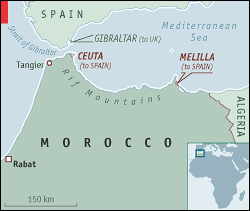Morocco was once a colony of France and Spain. However, the colonial rule had a profound impact on Morocco even after the country’s independence. It is critical to analyze the historical and current politics of Morocco to understand the impact of colonial rule on the country. Although some of the influences in Morocco were short-term, others prevailed in the long-term and still continue to dominate the country’s politics. The following discussion highlights some of the developments and changes that were influenced by France and Spain.
The distribution of colonies in Africa was based on the availability of the resources. The region in Western Sahara shared its borders with Algeria, Mauritania, and Morocco. Interestingly, the region was a favorite to many of the colonial powers. In fact, the French in Algeria and the Spanish in Morocco engaged in a conflict to determine who was to control the region. The confrontation was based on the mineral deposits found in the area (Zunes and Mundy 210).
The region was and still rich in phosphate and oil deposits. From historical records, the origin of the West Saharan conflict was sparked by the announcement that Spain had the mandate to control the territory (Jensen 14). Apparently, the announcement was made at a Berlin conference. Eventually, the colony was later divided and controlled by both Spain and France. In this regard, the Western Sahara fell under the governance of Morocco. On the other hand, the Eastern section fell under the governance of Liberia. Currently, the two different parts of the Western Sahara are governed and developed by the two countries. However, each country has resources that benefit each region.
In every country that Spain occupied, they claimed cities that are still under their influence. In most cases, the cities are still inhabited by Spanish citizens and have a representative from the Spanish government. The representative has the mandate of implementing policies and maintaining the cities. Similarly, during the colonial rule in Morocco, Spain claimed and developed cities in the country. In addition, Spain had total power and control over the activities within the cities.
For example, the cities of Ceuta and Melilla are some islands in Morocco still under the influence of Spain. The cities are designed in the status of Spain, and with fenced borders. The strategy is meant to prevent illegal immigrants from entering into the cities. The magnitude of the Spanish influence over the government of Morocco is evidenced from the regular humanitarian and financial aid. In addition, close ties between morocco and Spain is evidenced from the military troops stationed in the two cities. The troops maintain order and protect the inhabitants from the local populace. The inhabitants of the two cities are tourists from Spain who visit Morocco for sightseeing and other recreational activities.
The cities are strategically located near the sea and are easily linked to Spain through Malaga, Algeciras, and Almeria. The constant visits of the Spanish tourists to the country contribute to the Morocco’s foreign earnings. Ceuta and Melilla are considered part of Spain, therefore, the Spanish government have the right to choose and implement policies in the two cities. The Spanish government considers the two cities as the end of their territories in Africa. As a result, many of the inhabitants in Ceuta and Melilla are of Spanish culture that influences the Moroccan culture.

Morocco have political affiliations with the United States (Maghraoui 208). A treaty of peace and friendship between the two nations was ratified in 1787. The treaty is credited for the continued partnership between the United States and Morocco. The united states have always played a role in stabilizing the economy of Morocco. The United States promotes the need for economic, social and political stability in the country. Apparently, these are the essential elements of development in Morocco.
United States-based organizations have provided Morocco with financial support for many years. The support is aimed at helping the country maintain stability and improve the living standards of the citizens. Through the partnership, Morocco has received technological, educational, urban development, and other entrepreneurial systems from the United States.
On the other hand, the Moroccan government has provided support to America for a long time. After gaining independence, Morocco was the first country to acknowledge the sovereignty of the United States. In addition, Morocco promised a safe passage for American ships across the country’s borders. Morocco supports entrepreneurial and economic activities from the United States. The partnership between the United States and Morocco is bound by the Free Trade Agreement (FTA). The agreement binds the two countries through a common goal of economic progress (Maddy-Weitzman and Zisenwine 81).
In conclusion, the European influence in Africa and other colonies have affected the countries’ social, economic and political sectors. As indicated earlier, Morocco is one of the countries still under the influence of the Spanish government. However, this is evidenced from the constant state-state government deals especially on political and economic matters.
Works Cited
Jensen, Erik. Western Sahara: Independence or Integration with Morocco? Western Sahara: Anatomy of a Stalemate. London: Lynne Reinner Publishers, Inc., 2005. 13-17. Print.
Maddy-Weitzman, Bruce and Daniel Zisenwine. Mohammed IV and Moroccan Foreign Policy. Contemporary Morocco: State, Politics, and Society under Mohammed VI. New York: Routledge Publishers, 2012. Print.
Maghraoui, Driss. American Orientalism. Revisiting the Colonial Past in Morocco. New York: Routledge Press. Print.
Zunes, Stephen, and Jacob Mundy. Western Sahara: War, Nationalism, and Conflict Irresolution. New York: Syracuse University Press, 2010. Print.